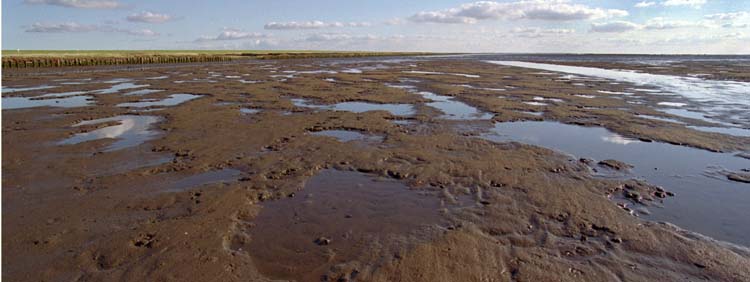The Wadden Sea
An introduction
Pictures on these pages are from the Danish section of the
tidalarea called the Waddenzee, or Wadden Sea situated in the
lover eastern corner of the North Sea. It’s not like the Grand
Canyon and nothing about this place reminds you of the Great
Barrier Reef, but it’s definitely something else, and you don’t
find anything like it elsewhere.
| The
pictures in this section are from the Tønder March in Denmark,
which is only the northern most section of the Wadden Sea. This
tidal area stretches way beyond the Danish border line. Down
south through Germany with the Frisian Islands, through Lower Saxony, 230 miles to Den
Helder of Netherlands, and in accordance the governments of Denmark,
Germany and Netherlands are working together on it’s protection and it’s conservation. |
In a Trilateral cooperation.
And now we are striving to get
this hole area written onto the Unesco list of World Heritage Sites. A
list of sites and
buildings around the world considered to be of special value to
humanity. No less. On the list you find, amongst the pyramids of Egypt,
the Grand Canyon and Australia’s, Great Barrier reef.
This latest Danish, soon to be,
contribution to the list is
flat and wide spread like a desert,
but its not a desert. It’s a feeling of space and a heaven so high and
blue, as that of the North sea itself, and it’s miles and miles of
water so low that you actually can drive your car across, at low tides. People regularly do so between
Jutland and the island of Mandø. A
3 and a half mile drive and a nice experience as long as you keep
an eye on the watch not to be caught midway when high tide comes.
Protected by dikes its an open
prosperous countryside with a history that goes as far back as that of
Europe’s, a history dominated by
tales of dike-buildings and
catastrophes, of new dike-buildings and new catastrophes and
floods. Tales of disasterous winter-storms where the waves of the big
neighbour, the sea, stole
everything away and left nothing behind.
A long line going back almost
800 years.
Much of it is remembered , but
over the decades.. most of it, no doubt,
is lost and mercifully forgotten.
As early as the year 1362, more than 150 years before
Columbus, a tale or a
legend is told of ”a big
drowning” with vague and (
we choose to think ) improbable and unlikely numbers of losses, such as
200.000 souls, but on an October night in 1634 we know for sure that
11-12.000 people lost their lives, and what a catastrophe that must have
been. It must have taken
years and years and generations before the marks were wiped away from the landscape, not to
mention from the minds.
That night the waters reached
6,1 meter above normal sea-level, or so they say, we didn’t really believe
them until that November-day in 1981 when we saw a frightening 5,01 meters.
Other remembered years are 1825
and that of 1839, but the 24th of November1981 was the last
time. A near catastrophe
that led to the building of a new dike a mile and a half further at sea. A bigger one and better one.
So now the 230 mile coastline of
the Wadden Sea from Denmark to Netherlands is safe. Or safer
anyway. Safer to people. When it comes to the animals, its a different
story.
Nature and birds are the ones that suffer
now..
| Northern
Lapwing (Vanellus vanellus) has decreased a fataly 80 % over the past 20
years. For most
other use-to-be commonly seen species such as Common Redshank (Tringa totanus) Blackheaded Gull (Larus ridibundus) its 60 %. And so it is for Corn Bunting (Miliaria calandra) Hedge Accentor (Prunella modularis) Isterine Warbler (Hippolais icterina) Sedge Warbler (Acrocephalus agricola) and Mew Gull (Larus canus). |
|

